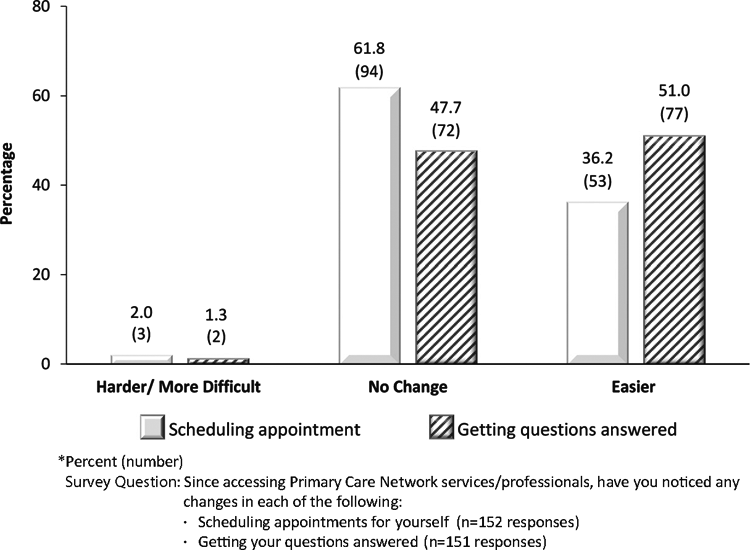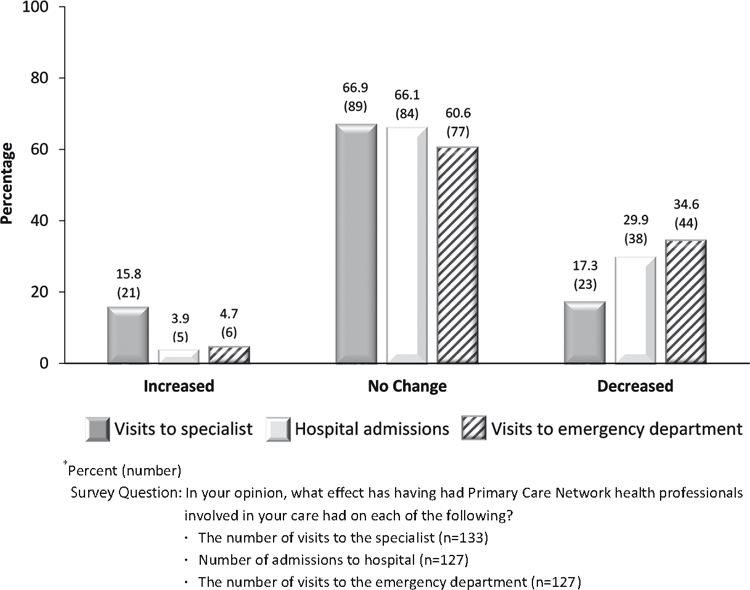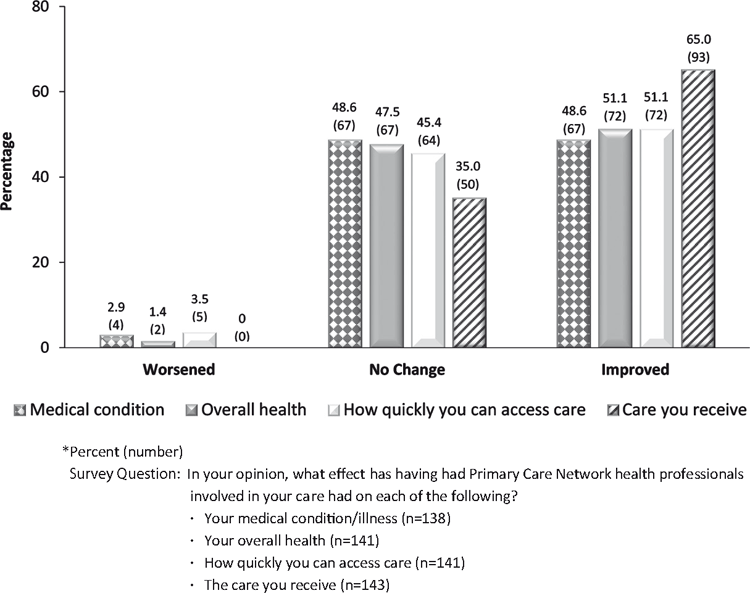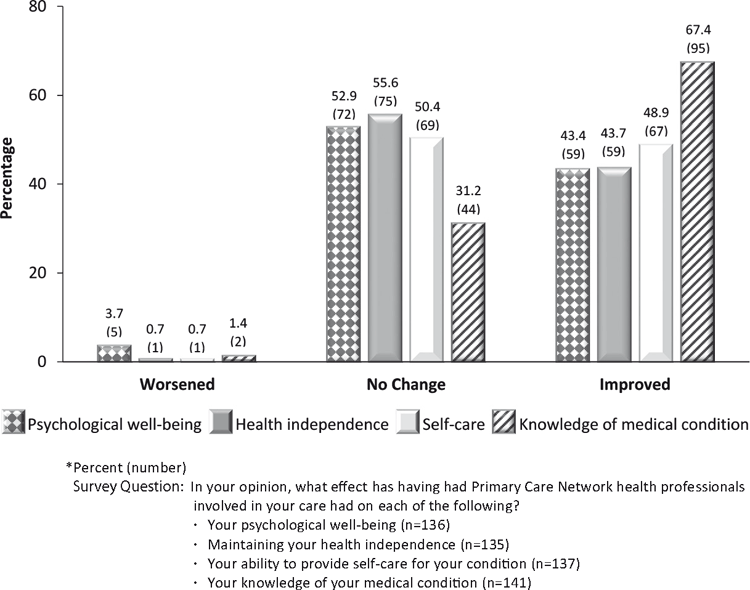Patients’ perceptions of team-based care in family practice: access, benefits and team roles
Olga Szafran 1 , Sandra L. Kennett 2 , Neil R. Bell 3 , Lee Green 41 Department of Family Medicine, University of Alberta, Edmonton, Alberta, Canada
2 Edmonton Oliver Primary Care Network, Family Medicine Clinic, Misericordia Community Hospital, Edmonton, Alberta, Canada; Currently: Primary Care, Health Canada, Edmonton, Alberta, Canada
3 Department of Family Medicine, University of Alberta Family Medicine Clinic, Misericordia Community Hospital, Edmonton, Alberta, Canada
4 Department of Family Medicine, University of Alberta, Edmonton, Alberta, Canada
Correspondence to: Olga Szafran, Department of Family Medicine, 6–10 University Terrace, University of Alberta, Edmonton, Alberta T6G 2T4, Canada. Email: olga.szafran@ualberta.ca
Journal of Primary Health Care 10(3) 248-257 https://doi.org/10.1071/HC18018
Published: 4 October 2018
Journal Compilation © Royal New Zealand College of General Practitioners 2018.
This is an open access article licensed under a Creative Commons Attribution-NonCommercial-NoDerivatives 4.0 International License.
Abstract
INTRODUCTION: The increasing complexity of health care and escalating prevalence of multiple chronic conditions have driven interprofessional team-based care in family practice. Most published studies examine team-based care from the perspective of health professionals. The purpose of this study was to examine patients’ perceptions of team-based care in family practice.
METHODS: This was a waiting room survey conducted in five family medicine academic teaching clinics in Edmonton, Alberta, Canada. Patients aged ≥18 years were invited to participate in a survey addressing patient access to team-based care, perceived benefits, preferred health professional and team member roles.
RESULTS: Of the 44.3% (565/1274) of respondents, 41.8% (231/552) reported receiving care from a team of health professionals, primarily for chronic disease management or pharmacy consultations. While there was a consistent pattern of patient perception that many aspects of care did not worsen with team-based care, improvements in knowledge of their medical condition (67.4%); the care received (65.0%); access to care (51.1%); ability to self-care (48.9%) and maintain their independence (43.7%); and overall health (51.1%) were reported. Some patients felt that team-based care reduced emergency visits (34.6%) and hospitalisations (29.9%), and 44.1% of patients felt that they had an active role on the team and made decisions about their care together with health professionals.
CONCLUSION: Patients perceive that team-based care in family practice has improved their knowledge and access to care, overall health and avoided some emergency department visits and hospital admissions. The findings support the continued development of team-based care in family practice.
KEYWORDS: Family practice; primary health care; patient care team; patient-centred care; patient participation; Canada
| WHAT GAP THIS FILLS |
| What is already known: Interprofessional team-based care is becoming an integral part of family practice, yet little is known about patients’ perceptions of the value of team-based care and how it affects their care and wellbeing. |
| What this study adds: Patients value team-based care for the benefits they feel they gain from having a group of health professionals involved in their care, such as improved access to care, increased education and knowledge about their condition and how to manage it, improved psychological wellbeing and health independence, which enhance patients’ quality of life. The findings support the continued development of interprofessional teams in primary care. |
Introduction
Interprofessional team-based care is becoming an integral part of family practice in Canada, but traditionally family physicians have practiced alone, even within group practices. The increasing complexity of health care and escalating prevalence of multiple chronic conditions have been the driving forces behind team-based care in family practice. The World Health Organization advocates for interprofessional, collaborative practice in the provision of care for chronic and complex conditions.1 The College of Family Physicians of Canada also promotes team-based practice as part of the Patient’s Medical Home.2 Team-based health care has been defined as ‘…the provision of health services to individuals, families, and their communities by at least two health providers who work collaboratively with patients and their caregivers — to the extent preferred by each patient — to accomplish shared goals within and across settings to achieve coordinated, high-quality care.’3 In family practice, a minimum team comprises a family physician and nurse. Often, it also includes other health professionals such as pharmacists, social workers, dietitians, exercise specialists, behavioural consultants and others.
Patient-centred care is a fundamental principle of family practice and, within the patient-centred approach to care (particularly for chronic illness), patients are an integral part of the team.4 Patient engagement in the decision-making affecting their care has increased compliance,5 motivated behaviour change and improved patient self-care.5,6 Studies have demonstrated that medical errors have been prevented7 and changes have been made in how health services are delivered8 with the engagement of patients in the health-care team. Involving patients as active team members has also sensitised health professionals to the real-life effect that medical decisions have on patients’ lives.9 Team-based health care improves continuity of care, enhances patient safety, increases the efficient use of scarce health resources, increases patient and provider satisfaction10,11 and improves clinical outcomes.12–15 Enhanced preventive care, improved patient education and reduced health-care costs have also been demonstrated through team-based care.16 Team-based care also results in shifting tasks from physicians to other health professionals, and creating increased capacity for physicians.17 However, patients have expressed concern about losing doctor–patient trust in a team-based model of care.18
Although patients consider themselves as members of their own health-care team,18 their role on the primary care team has not been well described. A study of Australian general practice patients with chronic illnesses reported that patients want to be recognised as partners in the management of their health care.19 They expect to ‘have a voice in their own care.’20 Patients’ perceptions have also been shown to affect their participation on the health-care team.21 The patient-centred approach has evolved into the Patient-as-Partner model, wherein patients are full participants on multidisciplinary teams.22
Except for physicians whom they consider to be team leaders, having overall responsibility for clinical decision-making about their care,18 patients’ awareness and knowledge of the roles of other health professionals on the team appears to be vague. Patients may be ill-informed about the full scope of skills that nurses may possess and do not consider nurses to be in the leadership role of making clinical decisions.18
To date, published studies on interprofessional teamwork have primarily examined health professionals’ perspectives on team-based care. There is a paucity of studies addressing patients’ perspectives on the perceived value of team-based care or how it affects their care. Patients’ views can provide insight into how team-based care has influenced their access to care, the perceived benefits that patients derive from receiving care from a team of health professionals, their satisfaction with the care received and the role(s) that health professionals are perceived to have on the primary care team. Patients’ perspectives are vital to understanding and improving patient outcomes, increasing treatment compliance, and enhancing quality of care. Therefore, the purpose of this study was to examine family practice patients’ experiences with and perceptions of interprofessional team-based primary care.
Methods
Study design and participants
A cross-sectional, anonymous waiting room patient survey was conducted at five family medicine academic teaching clinics affiliated with the Department of Family Medicine, University of Alberta in Edmonton, Canada. The survey was implemented over a 1-week period in each clinic, between 4 April and 22 July 2016. English-speaking patients aged ≥18 years who attended the clinics during this period were invited to participate. Patients aged <18 years and people who were not fluent in the English language were excluded. Consent to take part in the study was implied by returning a completed questionnaire. Ethics approval was obtained from the Health Research Ethics Board (Health Panel), University of Alberta (Pro00060018). Administrative approval was obtained from each of the participating sites.
Setting
At the time of the study, the academic teaching clinics of the department (ie Department of Family Medicine, University of Alberta in Edmonton, Canada) comprised family physician faculty members (who have full-time university appointments) and clinic preceptors; both groups saw patients and taught residents and other learners. Clinic staff included family practice nurses, medical office assistants and receptionists. Each clinic was also affiliated with a Primary Care Network (PCN) that provided access to other health professionals, such as chronic disease management nurses, diabetes educators, pharmacists, dietitians, behavioural health consultants, social workers and kinesiologists (movement and exercise professionals who differ from physiotherapists). PCNs were established and funded by the provincial government in 2003 to coordinate the delivery of primary care services and increase patient access to family physicians and frontline health professionals.23 Four clinics were affiliated with a decentralised PCN, with staff who were based full- or part-time at the clinic or travelled to the clinic to provide patient care services. One clinic was part of a centralised PCN where staff and services were located centrally and patients had to travel outside of the clinic to receive PCN services. The physicians practiced as part of an interprofessional team with clinic staff and PCN health professionals.
Survey questionnaire
Patients who volunteer were provided with a survey package containing a study information letter and survey questionnaire. Clinic receptionists distributed survey packages to patients who presented at the front desk for their appointment. The survey was completed in the waiting room and focused on patients’ experiences with receiving care from a team of PCN health professionals. Completed questionnaires were returned anonymously in a sealed envelope and deposited into a box provided in the waiting room.
The questionnaire addressed: access and referral to primary care team members; care of chronic diseases; health promotion, disease and injury prevention; patient education by team members; satisfaction and confidence with teamwork; and patient perceptions of the effect that teamwork has had on their health. Patients who received care from a team of PCN health professionals were asked to complete the entire questionnaire, whereas patients who did not receive team-based care did not complete questions related to perceptions of the care received from the PCN team, as these questions were not relevant to them. Patient access and referral to team-based care were measured on an ordinal scale (easier, no change, harder or more difficult). Patients’ perceptions of the effect of the care provided by PCN health professionals was also measured as ordinal (improved, no change, worsened; decreased, no change, increased).
Data analysis
Survey data were analysed descriptively (frequency, percentage, mean) using SPSS for Windows 24 (SPSS Inc., Chicago, IL, USA). Respondents were free to skip questions they did not wish to answer, so the total number of responses varied for each question. The data were analysed by gender and age group (<50 years vs. ≥50 years). Chi-Square tests were used to test for associations between variables. An level of 0.05 was used to test for statistical significance.
Results
Of 1274 eligible patients, 565 participated in the survey (44.3% response rate). Of the respondents, 348 (61.6%) were female, the mean age was 52 years (standard deviation (s.d.) = 16.8 years) and they were patients of the clinics on average for 15.5 years (s.d. = 11.7 years) (Table 1). Overall, 41.8% (231/552) of patients reported seeing a PCN health professional or using PCN services. A comparison of the demographic characteristics of patients who used PCN services versus the total respondents revealed no significant differences between the two groups (Table 1).
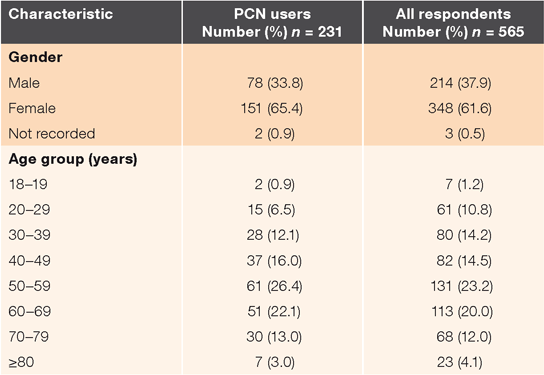
|
Patients who saw PCN professionals primarily saw the chronic disease management nurse (24.9%, 55/221) or pharmacist (21.3%, 47/221). The most frequent types of care received were follow-up tests or investigations (34.9%, 76/218) and medication reviews or changes (35.3%, 77/218). A significantly greater proportion of males than females reported using PCN services for the management of chronic diseases (42.9% vs. 24.6% respectively; P = 0.009) and for education on illness management (30.1% vs. 16.8% respectively; P = 0.04). A significantly greater proportion of younger patients than patients aged >50 years used mental health services (29.5% vs. 12.6%, P = 0.004), psychologists (13.9% vs. 2.8%, P = 0.004) and received mental health counselling (23.1% vs. 11.4%, P = 0.04). Patients aged ≥50 years were more likely to receive education about illness management (25.7% vs. 12.8%, P = 0.04) and medication reviews or changes (42.9% vs. 21.8%, P = 0.003).
Access and utilisation
Of the patients receiving care from PCN professionals, 36.2% indicated that it was easier for them to schedule appointments and 51.0% reported greater ease in getting their questions answered (Fig. 1). Since accessing PCN services, 39.9% (61/153) noted that the time to get an appointment was shorter, with essentially no change in the length of appointments (81.9%, 122/149). Most also reported no change in referrals to community services (71.7%, 91/127) or follow-up telephone calls (70.1%, 101/144). Some patients perceived that team-based care contributed to reducing their visits to the emergency department (34.6%), hospital admissions (29.9%) and specialist visits (17.3%) (Fig. 2).
Analysis by gender revealed that relatively more females than males reported either more (35.9% vs. 21.8%) or fewer (16.3% vs. 7.3%) appointments with other health professionals, whereas males tended to report no change (47.8% vs. 70.9%; P = 0.02). This was consistent with females, compared with males, who indicated that they travelled either more often (28.6% vs. 7.5%) or less often (13.2% vs. 7.5%) to other sites to receive care (P = 0.003). Compared to those ≥50 years, patients aged <50 years reported longer visits (17.9% vs. 4.3%, P = 0.02).
Perceived benefits and health improvements
The four most frequently noted benefits of receiving care from a team of health professionals were: (1) having access to a wide range of health professionals; (2) gaining a better understanding of one’s medical condition; (3) improving one’s ability to manage their own condition; and (4) having time to ask more questions during the visit (Table 2). Of the respondents who received care from a team of PCN health professionals, improvements in the care they received (65.0%), their access to care (51.1%), overall health (51.1%) and their medical condition (48.6%) were reported (Fig. 3). Team-based care was perceived to improve patients’ knowledge of their medical condition (67.4%), psychological wellbeing (43.4%), ability to self-care (48.9%) and maintain health independence (43.7%) (Fig. 4 ). While 71.2% (116/163) of patients were somewhat or very satisfied with the care provided by the health professionals team, 87.2% (143/164) had much or a great deal of trust in the team they received care from. Very few respondents (range 1.9–12.6%) indicated any disadvantages or expressed dissatisfaction.
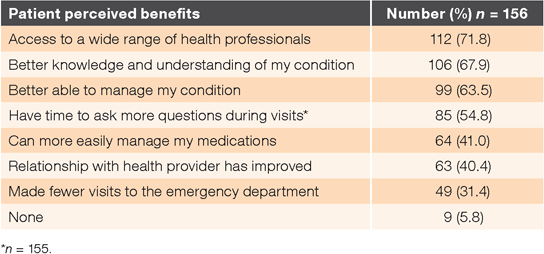
|
Compared to patients aged <50 years, patients aged ≥50 years reported better knowledge and understanding of their medical condition (55.6% vs. 74.5%, P = 0.03) and improved ability to manage their condition (50.0% vs. 70.6%, P = 0.02) and their medications (25.9% vs. 49.0%, P = 0.009).
Preferred health professionals
For medical management of illness or disease, almost all patients (93.7%, 134/143) preferred to receive care from a doctor rather than any other health professional. Overall, patients preferred to receive health education either from a doctor (35.7%, 46/129) or nurse (38.8%, 50/129), although compared to younger patients, patients aged ≥50 years preferred nurses for health education (23.4% vs. 47.6%, P = 0.01). Overall, 59.3% (80/135) of patients preferred to have their blood pressure taken by a nurse; 44.2%, (42/95) preferred to see a doctor for behavioural or mental health issues compared to 40.0% (38/95) who preferred to see the behavioural care consultant. For medication management, 66.9% (89/133) of patients preferred to see a doctor compared to 19.5% (26/133) who preferred a pharmacist.
Perceived roles on the team
Since receiving care from a team of health professionals, 36.1% (53/147) of patients reported having greater involvement in their own care. Overall, 44.1% of patients felt that their role was that of being an active member of the team and making decisions about their care together with health professionals; 20.4% felt that their role as a patient was to follow the treatment plan (Table 3). The four roles that patients most frequently perceived family doctors to have on the primary care team included: (1) to work collaboratively (70.9%); (2) to advocate on their behalf (58.8%); (3) to have overall responsibility for patient care (44.9%); and (4) to be the team leader (42.6%). The top four roles that patients most frequently perceived other health professionals to have on the team were: (1) to collaborate with others (80.6%); (2) to provide support (49.6%); (3) to educate patients about illness management (46.9%); and (4) to advocate on behalf of patients (46.5%). Compared to patients aged <50 years, patients aged ≥50 years were significantly more likely to indicate that doctors should delegate tasks to other health professionals (2.0% vs. 22.7%, P = 0.002).
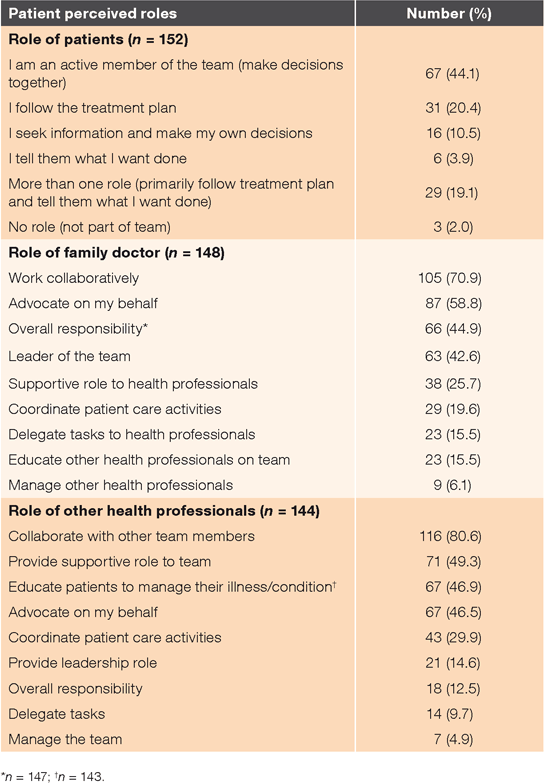
|
Discussion
This study provides new insight into patients’ experiences with team-based care and contributes to addressing the paucity of research in this area. While for most measures of care, patients reported no change, they do appear to value team-based care for the benefits they feel they gain from having other health professionals involved in their care, such as increased education and knowledge about their condition and how to manage it, and improved psychological wellbeing and health-care independence. These are important factors in enhancing patients’ quality of life. Our survey findings showing improved patient education are consistent with results of a randomised trial16 and indications of improved patient self-management support data obtained from focus groups.24
In Alberta, PCN team-based care was introduced with the explicit aim of improving patient access to family physicians and other health professionals.23 This study suggests that patients feel that their access to primary care has improved with team-based care in terms of greater ease in scheduling appointments and decrease in appointment wait times. Particularly notable is the perceived decrease in emergency visits and hospital admissions, which have a substantial effect on reducing acute care health-care costs. These patient perceptions have recently been confirmed by province-wide utilisation data demonstrating that patients receiving care within a PCN had fewer emergency visits and fewer hospital days than patients who were not affiliated with a PCN.25
Almost all patients preferred to receive care from a doctor, rather than any other health professional within the family practice clinics. Patients appear to identify doctors as the team leader who has overall clinical decision-making responsibility, with other health professionals functioning in a supportive role. This is consistent with another Canadian study reporting that only 48.3% of family practice patients would be willing to see a non-physician provider for a routine or follow-up visit,26 and a UK study indicating that patients preferred to discuss their medications with their doctor.27 A US study revealed that patients preferred doctors for their qualifications and technical skills, whereas nurse practitioners and physician assistants were preferred for their interpersonal skills.28 Our findings suggest that family practice patients still embrace traditional professional roles, even within an environment of interprofessional team-based care. Perhaps the teams that patients encountered in our study were at the early stages of teamwork, having not yet evolved into integrative team functioning, thus still adhering to traditional roles. Moreover, physicians may not readily share leadership roles with team members. A study of physicians’ perspectives on interprofessional teamwork found that family physicians also see themselves as the team leaders.29 The College of Family Physicians of Canada advocates for family physicians being the ‘most responsible provider’ within the Patient-Centered Medical Home,2 hence in the leadership role. Other health professionals have different perspectives on team leadership, which can result in tensions in professional relationships.30–33 Clarity of team member roles is necessary to avoid patient confusion and facilitate effective working relationships.
Patients want physicians and other health professionals to work collaboratively. Collaboration has been defined as ‘health-care professionals assuming complementary roles and cooperatively working together, sharing responsibility for problem-solving and making decisions to formulate and carry out plans for patient care.’34 This appeal by patients for collaboration among health providers resonates with research showing that interprofessional collaboration generates increased awareness of the knowledge and skills of other team members, resulting in superior decision-making.35
The finding that a considerable proportion of patients (44.1%) felt that they were an active team member, making decisions about their care together with health professionals, supports previous research indicating that patients expect to have an active voice in making decisions regarding their care.20 Canadian medical professional guiding principles also emphasise a culture of patient-centred care and the centrality of patients in their medical care.2,36 Factors facilitating or hindering patients being active members of the primary care team require further examination. Patient engagement in team-based care may require that health professionals need to make teamwork more visible to patients.
A consistent pattern of perception that certain measures did not worsen was observed in this study. The finding that most patients perceived no change in several measures should not necessarily be interpreted negatively, as there may be a fine balance between differences in perceptions of no change and improvement. It is possible that patients did not know of changes in models of care delivery if they receive the health care they need and want; in this case, the survey would reflect that their health-care needs were being met. It is also possible that patients may be more attentive to outcomes of care, rather than processes. Teamwork may be more of a professional construct and not be noticeable to patients.37 In cases where PCN health professionals are fully integrated into family practice clinics, patients may not be aware of PCN teams. In these instances, the boundaries between clinic staff and PCN professionals may be seamless, reflecting the ideal team-based care situation.
The study reveals age differences in the types of services accessed, with a greater proportion of patients aged <50 years using mental health services, whereas those aged ≥50 years accessed services for chronic disease management. The longer visits reported by patients aged <50 years can be attributed to counselling for mental health.
This study is limited in its cross-sectional nature and different results may be observed in the future or in different settings. The study reflects the views of relatively older patients, primarily females and patients attending the selected study clinics. Younger patients, males and non-attendees may have different perspectives. While the response rate may seem low, it is reasonable for such a survey.28 Not all patients who used PCN services provided responses to all questions, and the degree of response bias is unknown. The findings reflect patients’ perceptions, rather than objective measures, and are influenced by their personal experiences. The study data reflect patients’ subjective assessments of perceived changes in access or benefits to care since experiencing team-based care, rather than actual measures of differences between two models of care. Nonetheless, patients’ views are a valuable supplement to more quantifiable data obtained from the evaluation of health services delivery. Patient reported data may underestimate or overestimate actual measures. The study was conducted in a large Canadian city and in academic clinics and may not be generalisable to rural locations or non-academic family practice settings.
While patients’ perceptions of the care they receive are important and do matter, future studies should address objective measurements of the effect of team-based primary care on emergency visits, hospital admissions and appointment times. Studies addressing facilitators and barriers to patient involvement in team-based care, including cultural factors, are warranted.
Conclusion
Consistently, patients perceive that various measures of care have not changed since they accessed team-based care within the context of PCNs; and there may be a fine distinction between no change and improvement. In cases where improvement is noted, patients perceive that team-based care has improved their access to care, primarily as it relates to having access to a wide range of health professionals, shorter time to get an appointment and getting their questions answered. Patients also perceive that receiving care from a team of health professionals has improved their knowledge and understanding of their medical condition, enhanced their ability to provide self-care and improved their overall health. Some patients report that team-based care has had the effect of decreasing their visits to the emergency department and reducing hospitalisations. Overwhelmingly, patients perceive the family doctor as having overall responsibility for patient care and being the leader of the health-care team. However, they want health-care professionals to work together collaboratively on the health-care team. The findings support the continued development of interprofessional teams and their roles within primary care.
COMPETING INTERESTS
Drs Bell and Green are members of the Northern Alberta Academic Family Physicians (NAAFP). Dr Green chairs the NAAFP Endowment Fund committee but did not participate in the approval of funds for this project; Dr Bell is not a member of the NAAFP Endowment Fund committee. Ms Szafran and Ms Kennett declare that they have no conflicts of interest. The authors alone are responsible for the content and writing of the paper.
ACKNOWLEDGEMENTS
Funding for this project was provided by the Northern Alberta Academic Family Physicians Endowment Fund. Thank you to Peggy Lewis for providing administrative assistance for the study and performing data entry.
References
[1] World Health Organization. Framework for action on interprofessional education & collaborative practice. Geneva, Switzerland: WHO Press; 2010. [cited 2018 February 6]. Available from: http://www.who.int/hrh/resources/framework_action/en/[2] The College of Family Physicians of Canada. A vision for Canada: the Patient’s Medical Home. Position Paper. Mississauga, Ontario, Canada: The College of Family Physicians of Canada; 2011. [cited 2018 February 5]. Available from: http://www.cfpc.ca/A_Vision_for_Canada/
[3] Naylor MD, Coburn KD, Kurtzman ET, et al. Inter-professional team-based primary care for chronically ill adults: state of the science. Unpublished white paper presented at the ABIM Foundation meeting to Advance Team-Based Care for the Chronically Ill in Ambulatory Settings. Philadelphia, PA; 2010. [cited 2018 February 8]. Available from: https://www.nationalahec.org/pdfs/vsrt-team-based-care-principles-values.pdf
[4] Brown J. Patient-Centred Collaborative Practice. Ottawa: Health Canada; 2004.
[5] Bissell P, May CR, Noyce PR. From compliance to concordance: barriers to accomplishing a reframed model of health care interactions. Soc Sci Med. 2004; 58 851–62.
| From compliance to concordance: barriers to accomplishing a reframed model of health care interactions.Crossref | GoogleScholarGoogle Scholar |
[6] Katon WJ, Lin EHB, Von Korff M, et al. Collaborative care for patients with depression and chronic illnesses. N Engl J Med. 2010; 363 2611–20.
| Collaborative care for patients with depression and chronic illnesses.Crossref | GoogleScholarGoogle Scholar |
[7] Davies HTO, Nutley S, Mannion R. Organizational culture and quality of health care. Qual Health Care. 2000; 9 111–9.
| Organizational culture and quality of health care.Crossref | GoogleScholarGoogle Scholar |
[8] Crawford MJ, Rutter D, Manley C, et al. Systematic review of involving patients in the planning and development of health care. BMJ. 2002; 325 1263
| Systematic review of involving patients in the planning and development of health care.Crossref | GoogleScholarGoogle Scholar |
[9] Hogg C. Patients, Power and Politics – From Patients to Citizens. London: Sage Publications; 1999.
[10] Taylor KI, Oberle KM, Crutcher RA, Norton PG. Promoting health in type 2 diabetes: nurse-physician collaboration in primary care. Biol Res Nurs. 2005; 6 207–15.
| Promoting health in type 2 diabetes: nurse-physician collaboration in primary care.Crossref | GoogleScholarGoogle Scholar |
[11] Reeves S, Pelone F, Harrison R, et al. Interprofessional collaboration to improve professional practice and health care outcomes. Cochrane Database Syst Rev, 2017; CD000072
| Interprofessional collaboration to improve professional practice and health care outcomes.Crossref | GoogleScholarGoogle Scholar |
[12] Barrett J, Curran V, Glynn L, Godwin M. CHSRF Synthesis: Interprofessional Collaboration and Quality Primary Healthcare. Ottawa, Ontario: Canadian Health Services research Foundation; 2007. [cited 2018 February 6]. Available from: http://www.cfhi-fcass.ca/Migrated/PDF/SynthesisReport_E_FINAL.pdf
[13] Harris MF, Advocat J, Crabtree BF, et al. Interprofessional teamwork innovations for primary health care practices and practitioners: evidence from a comparison of reform in three countries. J Multidiscip Healthc. 2016; 9 35–46.
| Interprofessional teamwork innovations for primary health care practices and practitioners: evidence from a comparison of reform in three countries.Crossref | GoogleScholarGoogle Scholar |
[14] Jaruseviciene L, Liseckiene I, Valius L, et al. Teamwork in primary care: perspectives of general practitioners and community nurses in Lithuania. BMC Fam Pract. 2013; 14 118
| Teamwork in primary care: perspectives of general practitioners and community nurses in Lithuania.Crossref | GoogleScholarGoogle Scholar |
[15] Welp A, Meier LL, Manser T. The interplay between teamwork, clinicians’ emotional exhaustion, and clinician-rated patient safety: a longitudinal study. Crit Care. 2016; 20 110
| The interplay between teamwork, clinicians’ emotional exhaustion, and clinician-rated patient safety: a longitudinal study.Crossref | GoogleScholarGoogle Scholar |
[16] Litaker D, Mion LC, Planavsky L, et al. Physician-nurse practitioner teams in chronic disease management: the impact on costs, clinical effectiveness, and patients’ perceptions of care. J Interprof Care. 2003; 17 223–37.
| Physician-nurse practitioner teams in chronic disease management: the impact on costs, clinical effectiveness, and patients’ perceptions of care.Crossref | GoogleScholarGoogle Scholar |
[17] Schadewaldt V, McInnes E, Hiller JE, Gardner A. Views and experiences of nurse practitioners and medical practitioners with collaborative practice in primary health care - an integrative review. BMC Fam Pract. 2013; 14 132
| Views and experiences of nurse practitioners and medical practitioners with collaborative practice in primary health care - an integrative review.Crossref | GoogleScholarGoogle Scholar |
[18] Pullon S, McKinlay E, Stubbe M, Todd L, Badenhorst C. Patients’ and health professionals’ perceptions of teamwork in primary care. J Prim Health Care. 2011; 3 128–35.
[19] Infante FA, Proudfoot JG, Powell Davies G, et al. How people with chronic illnesses view their care in general practice: a qualitative study. Med J Aust. 2004; 181 70–3.
[20] van Dongen JJJ, de Wit M, Smeets HWH, et al. “They are talking about me, but not with me”: a focus group study to explore the patient perspective on interprofessional team meetings in primary care. Patient. 2017; 10 429–38.
| “They are talking about me, but not with me”: a focus group study to explore the patient perspective on interprofessional team meetings in primary care.Crossref | GoogleScholarGoogle Scholar |
[21] Cheong LH, Armour CL, Bosnic-Anticevich SZ. Primary health care teams and the patient perspective: a social network analysis. Res Social Adm Pharm. 2013; 9 741–57.
| Primary health care teams and the patient perspective: a social network analysis.Crossref | GoogleScholarGoogle Scholar |
[22] Karazivan P, Dumez V, Flora L, et al. The patient-as-partner approach in health care: a conceptual framework for a necessary transition. Acad Med. 2015; 90 437–41.
| The patient-as-partner approach in health care: a conceptual framework for a necessary transition.Crossref | GoogleScholarGoogle Scholar |
[23] Alberta Health, Government of Alberta (1995–2016). Primary care networks. Edmonton, Alberta, Canada: Government of Alberta. [cited 2018 February 5]. Available from: http://www.health.alberta.ca/services/primary-care-networks.html
[24] Van Berckelaer A, DiRocco D, Ferguson M, et al. Building a patient-centered medical home: obtaining the patient’s voice. J Am Board Fam Med. 2012; 25 192–8.
| Building a patient-centered medical home: obtaining the patient’s voice.Crossref | GoogleScholarGoogle Scholar |
[25] McAlister FA, Bakal JA, Green L, et al. The effect of provider affiliation with a primary care network on emergency department visits and hospital admissions. CMAJ. 2018; 190 E276–84.
| The effect of provider affiliation with a primary care network on emergency department visits and hospital admissions.Crossref | GoogleScholarGoogle Scholar |
[26] Carroll JC, Talbot Y, Permaul J, et al. Academic family health teams. Part 2: patient perceptions of access. Can Fam Physician. 2016; 62 e31–9.
[27] Tinelli M, Bond D, Blenkinsopp A, et al. Community pharmacy medicines management evaluation team. Patient evaluation of a community pharmacy medications management service. Ann Pharmacother. 2007; 41 1962–70.
| Community pharmacy medicines management evaluation team. Patient evaluation of a community pharmacy medications management service.Crossref | GoogleScholarGoogle Scholar |
[28] Leach B, Gradison M, Morgan P, et al. Patient preference in primary care provider type. Healthc (Amst). 2018; 6 13–16.
| Patient preference in primary care provider type.Crossref | GoogleScholarGoogle Scholar |
[29] Szafran O, Torti JMI, Kennett SL, Bell NR. Family physicians’ perspectives on interprofessional teamwork: findings from a qualitative study. J Interprof Care. 2018; 32 169–77.
| Family physicians’ perspectives on interprofessional teamwork: findings from a qualitative study.Crossref | GoogleScholarGoogle Scholar |
[30] Al Sayah F, Szafran O, Robertson S, et al. Nursing perspectives on factors influencing interdisciplinary teamwork in the Canadian primary care setting. J Clin Nurs. 2014; 23 2968–79.
| Nursing perspectives on factors influencing interdisciplinary teamwork in the Canadian primary care setting.Crossref | GoogleScholarGoogle Scholar |
[31] Freund T, Everett C, Griffiths P, et al. Skill mix, roles and remuneration in the primary care workforce: who are the healthcare professionals in the primary care teams across the world? Int J Nurs Stud. 2015; 52 727–43.
| Skill mix, roles and remuneration in the primary care workforce: who are the healthcare professionals in the primary care teams across the world?Crossref | GoogleScholarGoogle Scholar |
[32] Supper I, Catala O, Lustman M, et al. Interprofessional collaboration in primary health care: a review of facilitators and barriers perceived by involved actors. J Public Health (Oxf). 2015; 37 716–27.
[33] Martin DR, O’Brien JL, Heyworth JA, Mayer NR. The collaborative healthcare team: tensive issues warranting ongoing consideration. J Am Acad Nurse Pract. 2005; 17 325–30.
| The collaborative healthcare team: tensive issues warranting ongoing consideration.Crossref | GoogleScholarGoogle Scholar |
[34] O’Daniel M, Rosenstein AH. Professional communication and team collaboration. In: Patient Safety and Quality: An Evidence-Based Handbook for Nurses. Hughes RG, editor. Rockville, MD, USA: Agency for Healthcare Research and Quality, US Department of Health and Human Resources; April 2008. [cited 2018 February 5]. Available from: https://archive.ahrq.gov/professionals/clinicians-providers/resources/nursing/resources/nurseshdbk/nurseshdbk.pdf
[35] Christensen C, Larson JR. Collaborative medical decision making. Med Decis Making. 1993; 13 339–46.
| Collaborative medical decision making.Crossref | GoogleScholarGoogle Scholar |
[36] Canadian Medical Association. Health Care Transformation in Canada. Ottawa, Ontario: Canadian Medical Association; 2010. [cited 2018 February 8]. Available from: http://policybase.cma.ca/dbtw-wpd/PolicyPDF/PD10-05.PDF
[37] Hewitt G, Sims S, Greenwood N, et al. Interprofessional teamwork in stroke care: is it visible or important to patients and carers? J Interprof Care. 2015; 29 331–9.
| Interprofessional teamwork in stroke care: is it visible or important to patients and carers?Crossref | GoogleScholarGoogle Scholar |


